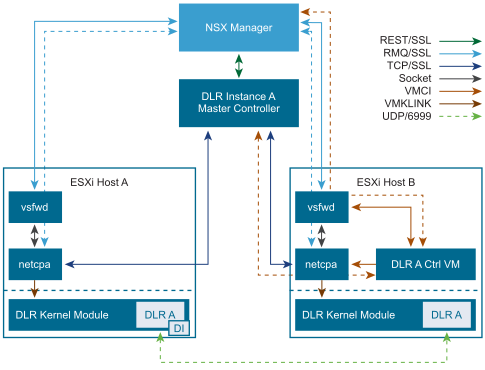This section provides a brief overview of the components of the DLR control and management planes.
The figure shows the components and the corresponding communication channels between them.

- NSX Manager:
- Has direct communications with the Controller Cluster
- Has a direct permanent connection with the message bus client (vsfwd) process running on each host prepared for NSX
- For each DLR instance, one Controller node (out of the available 3) is elected as master
- The master function can move to a different Controller node, if the original Controller node fails
- Each ESXi host runs two User World Agents (UWA): message bus client (vsfwd) and control plane agent (netcpa)
- netcpa requires information from the NSX Manager to function (for example, where to find Controllers and how to authenticate to them); this information is accessed via the message bus connection provided by vsfwd
- netcpa also communicates with the DLR kernel module to program it with the relevant information it receives from Controllers
- For each DLR instance, there is a DLR Control VM, which is running on one of the ESXi hosts; the DLR Control VM has two communication channels:
- VMCI channel to the NSX Manager via vsfwd, which is used for configuring the Control VM
- VMCI channel to the DLR master Controller via netcpa, which is used to send the DLR’s routing table to the Controller
- In cases where the DLR has a VLAN LIF, one of the participating ESXi hosts is nominated by the Controller as a designated instance (DI). The DLR kernel module on other ESXi hosts requests that the DI perform proxy ARP queries on the associated VLAN.